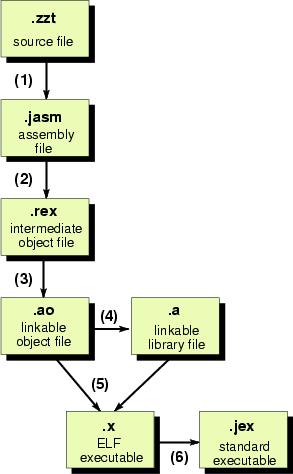Linker APEmille
HPC and Data for Lattice QCD
Linker APEmille
Status
The microcode linker seems functional now. All known bugs
have been fixed. Some more may lurk around, however. So please test
(and send bug reports).
The current versions are :
- elf tools 0.17.5, dated 2003/10/17.
- binutils beta12, dated 2002/03/21.
The last updates fix :
- a bug that appeared in very large object files and made the program crash horribly.
- a problem with psk output of specific lenths.
xtc will never work correctly with the linker since it's internal
structure makes linking impossible in some cases.
Patches for the above exists but quickly reached "very dirty hack"
status and will be omitted from the official xtc distributions.
With rtc >= 0.1.36 , linker operation seems now ok.
Features / Known bugs
- The linker does not detect situations where variables marked as extern are actually never instantiated. This may lead to memory corruption.
Download
To install all linker tools download the latest elf and binutils packages and unpack them in one of the root directories (e.g. $LROOT).binutils contains the GNU linker and some support tools and the elf package contains conversion programs from .jex to and from ELF .ao format.
Tutorial
The APEmille Microcode Linker project was started in view of the need to easily reuse existing code without going through the whole compilation/optimization process over and over again (a rather longish process on all APE machines), and also to allow a more flexible use of optimization levels and even optimizer versions.For APEmille there already did exist a completely different linker project. It did link code at the assembly level however, and thus is most suited for generating simulator (SF) code.
The Microcode Linker links shaked object files that are produced by an adapted shaker (such as psk or flint) and a subsequent converter.

Linking Steps
-
A TAO compiler creates an assembly source file.
-
The assembler/shaker creates an intermediate microcode object format
(This step is most often merged with the next one)
-
A converter program brings the file into a suitable format to be use by the linker and the linker utilities.
-
Object files can, of course, be collected into libraries.
-
The linker combines object files and libraries to an executable.
-
If the executable produced in step (5) is not directly loadable by the OS, another tool can convert it back to the standard JEX format.
The software versions of the relevant APEmille tools that are believed to function correctly with the ald linker are listed below. Don't even think of trying it while using older versions than listed!
| Required Software Versions | ||
| rtc | (TAO compiler) | >= 0.1.36 |
| psk | (shaker) | >= 2.2 |
| ELF tools | (format converter) | >= 0.17.5 |
| ald | (linker) | >= 2.9.1 APE beta12 |
The Linker Tools
- ald
- The linker proper. It's a straightforward port of the GNU ld linker (version 1.9.1) with only the few necessary changes to support the requirements of the APEmille microcode.
- aar
-
The GNU ar program (renamed aar for APEmille) creates,
modifies, and extracts from archives. An archive is a single file
holding a collection of other files in a structure that makes it
possible to retrieve the original individual files (called members
of the archive).
Please refer to the UNIX man page of ar for usage information.
- astrip
-
The GNU strip program (renamed astrip for APEmille) strips
the symbol table from ELF files.
This mainly useful after linking to reduce the size of the executable file. - aobjdump
- The GNU objdump program. Use it to examine .ao files.
- jex2elf
-
A converter between REX and ELF files.
Usually called by the shaker. - elf2jex
-
A converter between ELF and JEX files.
Currently called manually before execution.
The following rules apply to TAO programmers wishing to use the linker:
- The main program must be enclosed in
begin main
end main - Compile always using the '-c' flag.
- External data must be declared as such using the same declaration
as the data's home modules, e.g.:
extern complex field[100] - External subroutines need not be declared since rtc does
it for all calls.
Note: rtc requires strict type conformance of declaration and use of a subroutine, i.e. calling a subroutine with differently typed arguments than declared by the routine will result in a linker error. - The order in which modules are linked is not important. The order does however affect the memory layout. So users who wish to re-use the memory contents of a previous run should carefully place all relevant data into the first module.
- The linker treats globally declared floating point
data similar to FORTRAN common blocks, i.e. they may be declared
multiple times but should have the same size everywhere.
This "feature" was introduced to faciliate the transition to using the linker, otherwise the multiple inclusion of files that contain declarations would result in long error lists.
% rtc-try -c main.zzt This try version of rtc was generated on Fri May 25 19:31:42 MEST 2001 |
Object files contain several types of sections :
- Program memory (sections .tzpm and .jndm).
- Global (i.e. externally visible) Jmille data (section *COM*).
- Local (i.e. private) Jmille data (section .jndata).
- Global and local Tmille data (section .tzdata).
- Constant blocks that include also the slice information (sections .tconxx and .jconxx ).
- Memory allocation sections for the above constants (sections .tzbss and .jnbss).
The linker rearranges and merges the sections as shown below.
The program sections of each module are genrally padded up to the next
page boundary (1 page = 0x100 cycles) due to the embedded page
fault jumps that cannot be moved by the linker. A linked
executable is therefore always larger than an equivalent single-source-file
program.
